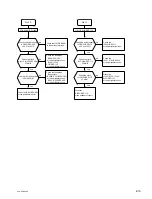
PCS-G50/G50P
3-6
3-2. Circuit Description of PCS-PG50/
PG50P
The following describes the functions of each circuit block
of PCS-PG50/PG50P.
CPU Block [CPU-382]
This block, comprising a CPU, flash memory, SDRAM,
SRAM, Disk On Chip, system/bus controller, buffers,
serial interface for debugging and an RTC, controls the
overall system including optional products.
Video In Block [DSP-113]
This block comprises two sets of video input buffer, video
decoder and noise reduction IC. Analog video input signals
(YC IN and Composite IN) are converted to digital signals,
Y/C separated, decoded from chrominance signals to U/V
signals, and are then output to the VIA block through the
noise reduction IC as 8-bit digital data (ITU-R656 format).
This block also selects input signals.
Video Pre-processing Block [DSP-113]
This block comprises two sets of video input ASIC and
SDRAM. The ASIC, incorporating Temporal Filter and
Scaller, performs pre-filtering for compression and coding
of signals from the Video In block, and then outputs the
signals to the Video FPGA block. The ASIC also functions
as a host interface for reading/writing still pictures. This
block also controls the video decoders through the I2C
interface.
Video FPGA Block [DSP-113]
This block, comprising an FPGA and SDRAM, controls
input signals from the VIA block, input/output signals
from/to the CODEC block, and output signals to the video
Display (1) Block and Audio FPGA block (7 inputs, 6
outputs). This block has functions to combine two screens
and output a video signal.
Video Display (1) Block [CPU-382]
This block, comprising a video display IC and SDRAM,
has a “PinP” display function for two video input signals
from the Video FPGA block, and a host interface function
for reading/writing still pictures. This block also transfers
signals to the video Display (2), Audio FPGA and CODEC
blocks.
Video Display (2) Block [CPU-382]
This block, comprising a video output ASIC and SDRAM,
has a graphics (menu) and still picture display function that
overlays graphics onto moving/still picture video signals.
This block also controls the video encoders (MONITOR
OUT) through the I2C interface.
Audio FPGA Block [CPU-382]
This block, comprising an FPGA, controls communication
between the Echo Canceller block and the CPU, data
communication with PCSA-A7 (echo cancelling
microphone), and auto-transmission of the boot program.
This block has a function to select four video input signals
from the Video FPGA, video Display (1) (2 inputs) and
video Display (2) blocks and to output four signals (video
encoder: 2, graphic accelerator: 2). This block also controls
the RTC through the I2C interface.
RGB Display Block [CPU-382]
This block, comprising a graphic accelerator and SDRAM,
has functions to display graphics and still pictures and to
overlay video input signals from the Audio FPGA block.
Analog R/G/B output signals (XGA) and NTSC/PAL
output signals can be displayed, but either one of the
signals is output. The NTSC/PAL signals are transferred to
the video selector and video amplifier in the Video Out
block.
Video Out Block (MONITOR VIDEO OUT)
[CPU-382]
This block comprises two video encoders, video selectors,
video amplifiers and video drivers. The 8-bit digital video
input signals (ITU-R656 format) from the Audio FPGA
block are encoded by the video encoder, converted to
analog signals, and are input to the video selectors together
with the signals from the RGB Display block. Three video
signals are selected and are then output to the data solution
box (PCSA-DSB1S) and to external units through the
amplifiers and drivers.
Содержание Ipels PCS-G50
Страница 6: ......
Страница 16: ......
Страница 26: ......
Страница 34: ......
Страница 170: ......
Страница 186: ......
Страница 191: ...PCS G50 G50P 8 7 8 7 CPU 382 B SIDE SUFFIX 12 13 A B C D 1 2 3 4 CPU 382 CPU 382 ...
Страница 198: ......
Страница 199: ......
Страница 200: ...Printed in Japan Sony Corporation 2005 6 22 2005 PCS G50 UC PCS G50P CE E 9 968 181 01 ...
















































